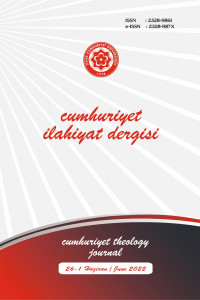Erken Dönemde İstihsân Tanımları Etrafında Oluşan Meşrûiyet Tartışmaları
Discussions Around Legitimacy of the Istihsân’s Definitions in the Early Period
Author(s): Abdulmuid AykulSubject(s): History of Law, Sharia Law
Published by: Cumhuriyet Üniversitesi İlahyat Fakültesi
Keywords: Fiqh; Qiyas; Istiḥsān; Definition; Muḥammad b Hasan al-Shaybānī;
Summary/Abstract: In legal methodology (usul al-fiqh), the problem of the defining istiḥsān and the legitimacy of its definition is among the critical discussion topics. To overcome the rigorism of law, istiḥsān was used by the founder scholars of Ḥanafī school of law and Malik b. Anas (d. 179/795)- however this use received various objections. Although the Mālikī scholars also used istiḥsān strong criticisms of istiḥsān have been directed on the Ḥanafīs. After the severe criticism of Muḥammad b.Idrīs al-Shāfiʿī (d. 204/820), the Ḥanafī scholars carried out various intellectual activities to define istiḥsān and to prove that it is legitimate. This process -which started especially with Abū’l-Ḥasan al-Karkhī (d. 340/952) and Abū Bakr al-Rāzī al-Jaṣṣāṣ (d. 370/981), revealed a rich accumulation with the contribution of the legal theorists in other school of laws. It is known that al-Karkhī's definition of istiḥsān has become widespread among the legal theorists, and the legitimacy of istiḥsān in the works of legal theory was based on his definition. AlKarkhī's considerations on the legaliticamy of using istiḥsān can be traced in his student al-Jaṣṣāṣ, in the following centuries, Abū Zayd al-Dabūsī (d. 430/1039), Abū l-‘Usr al-Bazdawī (d. 482/1089) and Shams al-Aimma al-Sarakhsī (d. 483 /1090)’s works. Al-Jaṣṣāṣ' explanations on the legitimacy of istiḥsān begin with the criticism of Imam al-Shāfiʿī's against istiḥsān. He provides the proof of legitimacy for istiḥsān in divided two sub-headings. Al-Jaṣṣāṣ, who deals with istiḥsān in two parts as word and meaning, argues that there is no disagreement about the use of istiḥsān and that all mujtahids accept istiḥsān, and even Imam al-Shāfiʿī, who opposes to the use of istiḥsān, employs istiḥsān in this sense. The type of istiḥsān on which there is a deabte is the istiḥsān used in relation to its meaning. Al-Jaṣṣāṣ states that this use is a qiyas operation; he justifies his point of view by referring to the works of Muḥammad b. Hasan al-Shaybānī (d. 189/805). Indeed, when we look at how Imam Muḥammad explained the istiḥsān’s examples in his works, it is seen that there are two conflicting juristic analogy (qiyas) made in many examples. Moreover, Imam Muḥammad openly considered some types of istiḥsān part of qiyas by stating that some examples “can be included in this type of istiḥsān.” Ḥanafī scholars wanted to break the hostile atmosphere toward istiḥsān by defining and evaluating the istiḥsān in a way that their opponents could accept. The definition of Istiḥsān “to abandon the judgment given to similar ones due to stronger evidence.” has been generally accepted. In this definition, istiḥsān is defined by associating with qiyas, and referred to an istihsan that is presented as the more substantial evidence, and qiyas is the weaker evidence. Although it is appropriate to define istiḥsān in relation to qiyas, the claim that in the definition istiḥsān is put in stronger place than qiyas might casuse to some the contradictions- in particular when the example’s of Imam Muhammad are taken into consideration. Because in most cases, when qiyas conflicts with istiḥsān, istiḥsān is taken. But in an opposite case, qiyas might be taken. Apart from these, there are examples of the types of istiḥsān that al-Karkhī has classified in the works of Imam Muḥammad, but sometimes there are also strange situations such as taking the qiyas by istiḥsān. This also means that the term is not sufficiently defined. The negative attitude towards istiḥsān in some Shāfiʿī circles and the criticisms against the legitimacy of istiḥsān continued in the works of the fiqh method. Istiḥsān is defined as making a judgment without evidence by Shāfiʿī circles. Therefore, they did not accept the abandonment of qiyas, which is a sharī proof, because of istiḥsān, which is a non-sharī notable proof. Based on the examples given by the users of istiḥsān, Ibn Ḥazm (d.456/1064), one of the Ẓāhirītes, claims that istiḥsān opens the door to arbitrariness. According to him, a situation that is accepted as istiḥsān according to Ḥanafīs can be taken as istiḥsān according to Mālikīs. This creates an apparent contradiction. There are some valid points in the assessment of Ibn Ḥazm. Because while it is seen that the istiḥsān of Mālikīs is criticized in Imam Muḥammad's book named al-Ḥujjah ʿalā Ahl al-Madīnah, it can be also found that the istiḥsān of Ḥanafīs is charged in the works of Abū’lWalīd Sulaymān al-Bājī (d. 474/1081), one of the Mālikīs. The criticism toward istiḥsān was continued by Shāfiʿīs such as Abū Isḥāq al-Shīrāzī (d. 476/1083), Imam al-Haramayn al-Juwaynī (d. 478/1085) and Abū Ḥāmid al-Ghazālī (d. 505/1111). While al-Juwaynī sees istiḥsān as a method based on the lust of the soul, not istinbat/legal deduction, al-Ghazālī understands istiḥsān as a personal comment. The main reason for the negative attitude towards istiḥsān is that the content based on the definitions, has been neglected most of the time. However, when we look at the works of Imam Muḥammad, it can be seen that there is a proof of istiḥsān contrary to what is believed-and that this can be sometimes a work, sometimes a necessity, sometimes another comparison, or sometimes a custom.
Journal: Cumhuriyet İlahiyat Dergisi
- Issue Year: 26/2022
- Issue No: 1
- Page Range: 173-190
- Page Count: 18
- Language: Turkish

